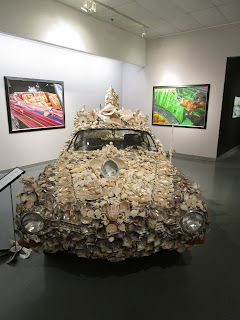 |
| Street scene along The Strand |
And big giant mega cruise ships close in sight, Historic Galveston is a cruise port.
It is a cruise port without nearly enough to keep a cruise ship that size happy and content with things to do, There are some very nice older buildings, such as this:
And this:
There are historic markers identifying the ages of various interesting buildings:
The sidewalks and streets are nice and wide, which doesn't seem to fit the historic nature, but is welcome nevertheless:
And there are cool little quirks here and there:
But there's not enough there there. Yes, I did have a delicious milkshake at La King's candy store (which was filled with kids acting like, yes, kids in a candy store). But my Tex-Mex food was kind of "meh" at the historic Original Mexican Cafe.
Basically, Galveston is a downscale beach town. (Not that there's anything wrong with that -- I like some downscale beach towns, dislike others, but I like more downscale beach towns than I do upscale beach towns.) A downscale beach town with a small historic district attached, with a cruise ship port attached to that.
There is one very interesting quirk that resulted from the last major hurricane that crossed Galveston Island, which was Ike in 2008. The trunks of a number of trees that were otherwise destroyed in the hurricane have been carved into sculpture. I found a few here and there:
This was just in the front yard of a small apartment building, My favorite were these in a small park next to the Galveston Fire Department:
That's a dog in the foreground, looking forlornly at ...
An elevated fire hydrant,
It works for so many reasons in this locale. These sculptures give Galveston something the cruise ships, dessert restaurants, and T-shirt shops can never give: character.
This was the highlight of Galveston Day,








































